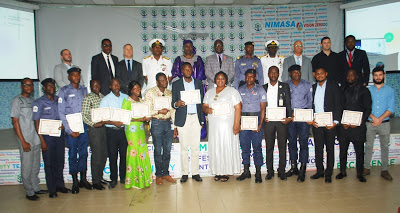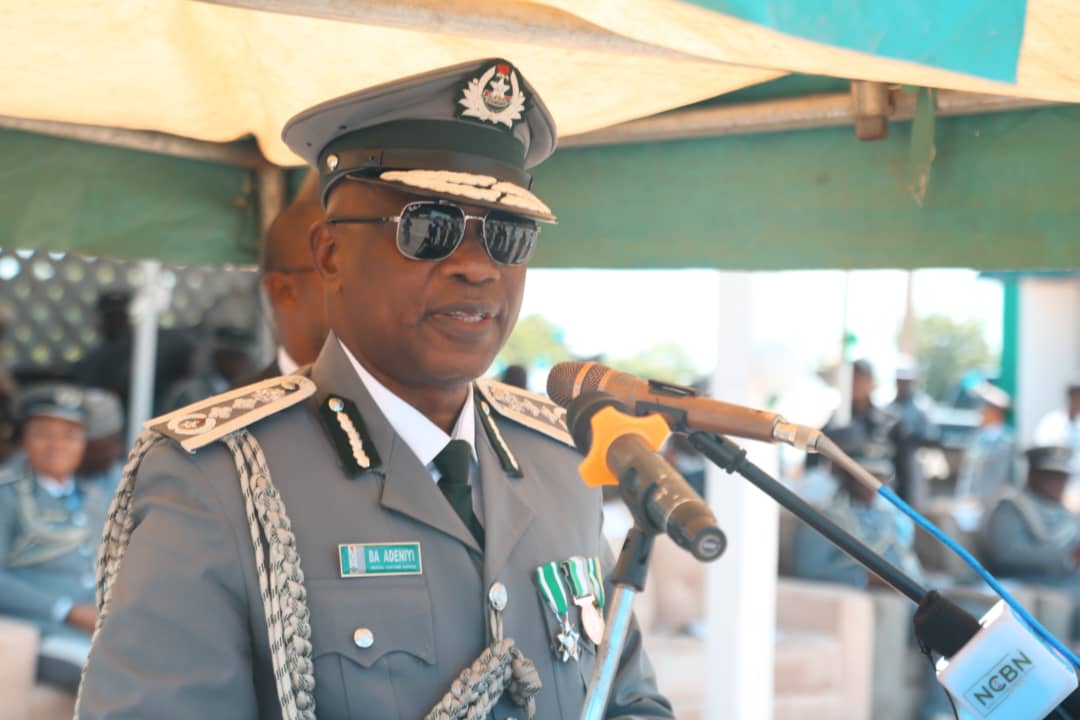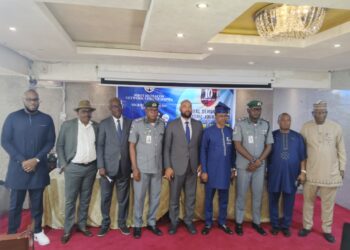· As NIMASA graduates new Intelligence
Officers under Deep Blue Project
Officers under Deep Blue Project
 |
| A cross section of graduating students and officials at the graduating ceremony of the C4i operator course. |
In another major step towards the
full realisation of an integrated surveillance and security architecture to
broadly tackle insecurity in Nigeria’s waterways, up to the Gulf of Guinea, the
country has taken delivery of the first special mission vessel under the Deep
Blue Project.
Chairman of the Project
Monitoring Team for the Deep Blue Project, also known as Integrated National
Security and Waterways Protection Infrastructure, Mrs. Olu Mustapha, disclosed
this recently in Lagos at a graduation ceremony organised by the Nigerian
Maritime Administration and Safety Agency (NIMASA) for a new set of C4i system
operators.
Monitoring Team for the Deep Blue Project, also known as Integrated National
Security and Waterways Protection Infrastructure, Mrs. Olu Mustapha, disclosed
this recently in Lagos at a graduation ceremony organised by the Nigerian
Maritime Administration and Safety Agency (NIMASA) for a new set of C4i system
operators.
The Command, Control, Computer
Communication and intelligence (C4i) centre located at the NIMASA-owned
Nigerian Maritime Resource Development Centre (NMRDC), Kirikiri, acts as the
nerve centre for operations and workflow management for all platforms under the
Deep Blue Project. The graduation of the C4i operators marks another milestone
towards the total commencement of the project.
Communication and intelligence (C4i) centre located at the NIMASA-owned
Nigerian Maritime Resource Development Centre (NMRDC), Kirikiri, acts as the
nerve centre for operations and workflow management for all platforms under the
Deep Blue Project. The graduation of the C4i operators marks another milestone
towards the total commencement of the project.
Mustapha, who is also the
Director, Project Services, at the Ministry of Defence, said the essence of the
training for the intelligence officers was to ensure adequate capacity to man
the assets under the Deep Blue Project, especially with commencement of the
receipt of the special assets.
Director, Project Services, at the Ministry of Defence, said the essence of the
training for the intelligence officers was to ensure adequate capacity to man
the assets under the Deep Blue Project, especially with commencement of the
receipt of the special assets.
According to her, “The assets of
the Deep Blue Project must be manned by competent personnel and that is what we
are committed to through various training programmes for different components
of the project. This graduation of C4i system operators will produce additional
personnel for the optimisation of the system.”
the Deep Blue Project must be manned by competent personnel and that is what we
are committed to through various training programmes for different components
of the project. This graduation of C4i system operators will produce additional
personnel for the optimisation of the system.”
In his remarks, the
Director-General of NIMASA, Dr. Dakuku Peterside, lamented the negative effects
of insecurity in the Nigeria maritime domain and the Gulf of Guinea. Dakuku
said the President Mohammadu Buhari administration was committed to
diversifying the economy and saw maritime as an economic game changer in this
direction. He said security of the maritime environment was a top priority of
the administration.
Director-General of NIMASA, Dr. Dakuku Peterside, lamented the negative effects
of insecurity in the Nigeria maritime domain and the Gulf of Guinea. Dakuku
said the President Mohammadu Buhari administration was committed to
diversifying the economy and saw maritime as an economic game changer in this
direction. He said security of the maritime environment was a top priority of
the administration.
Dakuku stated, “The Nigerian
maritime domain and the Gulf of Guinea are known globally as major maritime
security flashpoints. In addressing the challenges, a bi-ministerial
collaboration of the Federal Ministries of Defence and Transportation, as well
the Office of the National Security Adviser (NSA) developed a maritime security
architecture comprising all military and security services as well as NIMASA to
ensure a conducive environment for maritime to thrive.”
maritime domain and the Gulf of Guinea are known globally as major maritime
security flashpoints. In addressing the challenges, a bi-ministerial
collaboration of the Federal Ministries of Defence and Transportation, as well
the Office of the National Security Adviser (NSA) developed a maritime security
architecture comprising all military and security services as well as NIMASA to
ensure a conducive environment for maritime to thrive.”
Dakuku, who was represented by
the Agency’s Executive Director, Operations, Engr. Rotimi Fashakin, added that
the Federal Government, through NIMASA, had invested ample resources in
infrastructure, including the critical manpower component required to run the
Deep Blue Project effectively and efficiently.
the Agency’s Executive Director, Operations, Engr. Rotimi Fashakin, added that
the Federal Government, through NIMASA, had invested ample resources in
infrastructure, including the critical manpower component required to run the
Deep Blue Project effectively and efficiently.
The DG asked the graduands to
bring the skills and experience they acquired during their training to bear on
the national security assignment.
bring the skills and experience they acquired during their training to bear on
the national security assignment.
The highlight of the event was
the presentation of a certificates by Mustapha to the 24 graduands including
Mr. Ibrahim Gana, who emerged the best graduating student.
the presentation of a certificates by Mustapha to the 24 graduands including
Mr. Ibrahim Gana, who emerged the best graduating student.
It would be recalled that the C4i
centre was commissioned in August. It is equipped with alert setting
capabilities, Coastal Automatic Identification System (AIS), and SAT AIS signals
all over the world, in liaison with some international security networks, for
access to database for vessel movement, with capacity for six-year
retrospective monitoring of vessels movement.
centre was commissioned in August. It is equipped with alert setting
capabilities, Coastal Automatic Identification System (AIS), and SAT AIS signals
all over the world, in liaison with some international security networks, for
access to database for vessel movement, with capacity for six-year
retrospective monitoring of vessels movement.































































